MGT605 - Exploring Leadership and Sustainability in Sports Management
VerifiedAdded on 2023/06/11
|10
|2211
|157
Project
AI Summary
This business capstone project proposal investigates leadership and sustainability challenges within the global sports management industry. It begins with an introduction to the complexities of the sports industry, highlighting the need for collaborative leadership approaches. The literature review focuses on transformational leadership and the leadership development framework, emphasizing their relevance in addressing organizational challenges. The research questions center on the problems faced by sports management authorities in terms of leadership and sustainability. The methodology outlines the use of primary data collection through surveys and secondary data analysis of existing literature. The research process employs an inductive approach, utilizing grounded theory for data analysis. The project aims to analyze data collected from 50 respondents using descriptive statistics and regression analysis to assess the influence of various factors on sports management. The proposal concludes by reiterating the importance of transformational leadership and leadership development in addressing the evolving demands of the sports industry.
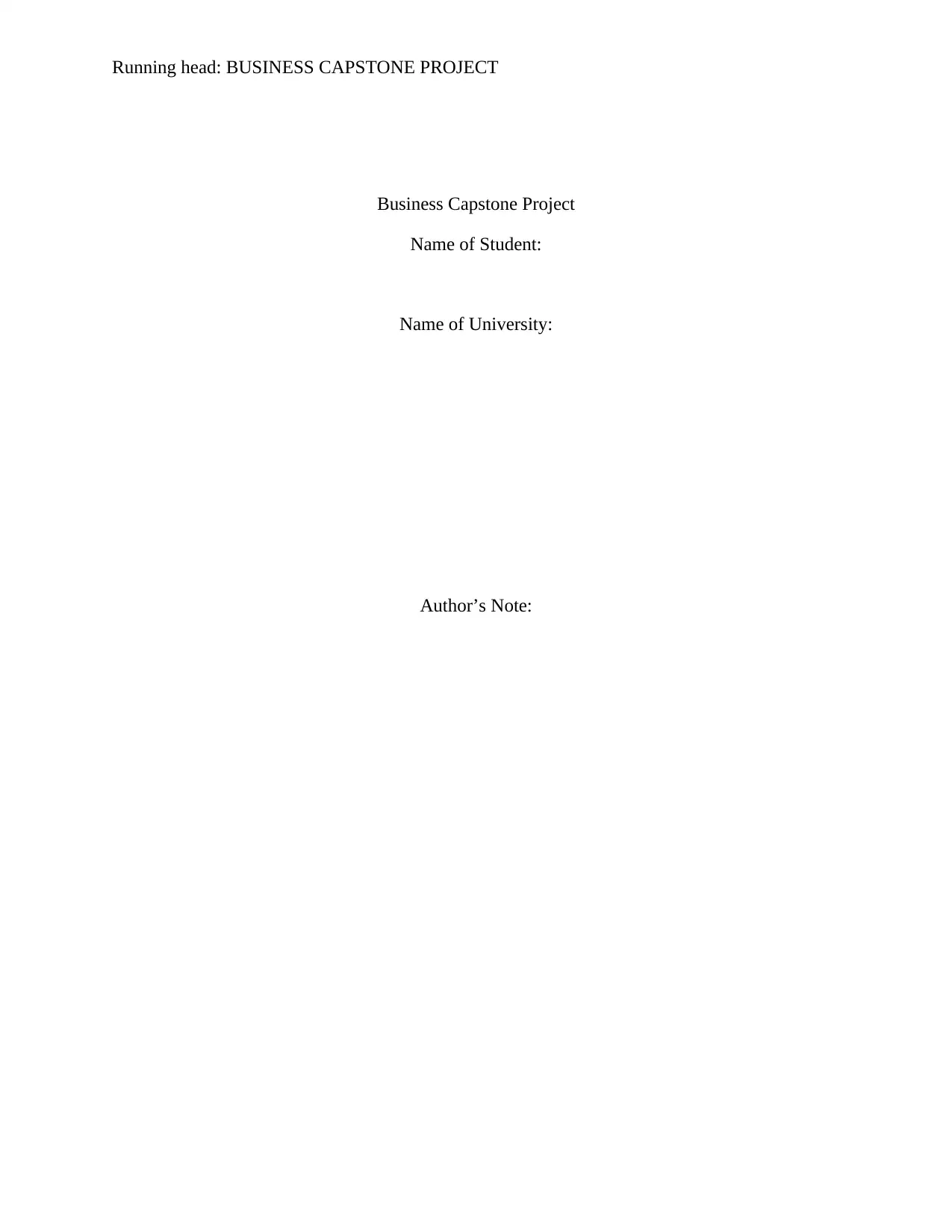
Running head: BUSINESS CAPSTONE PROJECT
Business Capstone Project
Name of Student:
Name of University:
Author’s Note:
Business Capstone Project
Name of Student:
Name of University:
Author’s Note:
Paraphrase This Document
Need a fresh take? Get an instant paraphrase of this document with our AI Paraphraser
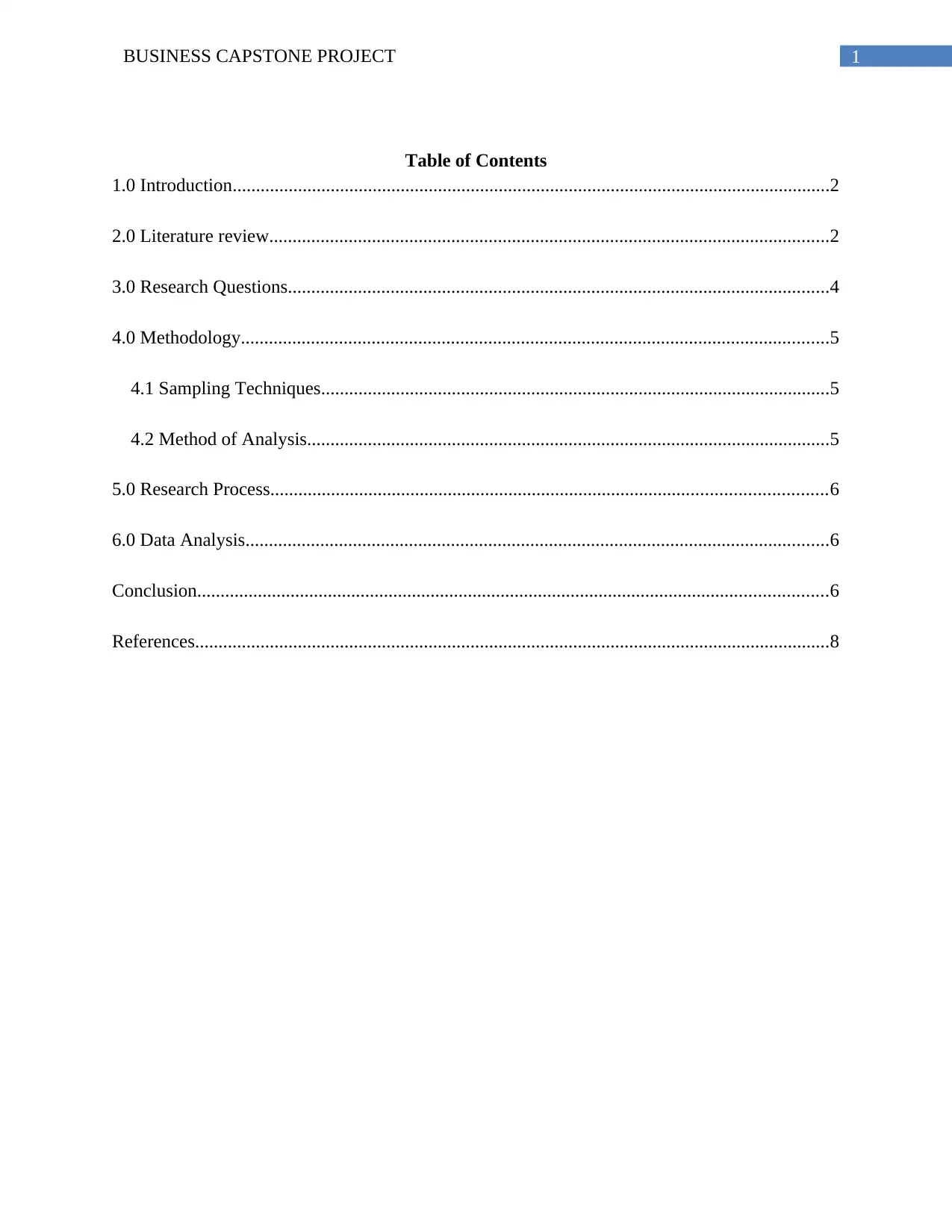
1BUSINESS CAPSTONE PROJECT
Table of Contents
1.0 Introduction................................................................................................................................2
2.0 Literature review........................................................................................................................2
3.0 Research Questions....................................................................................................................4
4.0 Methodology..............................................................................................................................5
4.1 Sampling Techniques.............................................................................................................5
4.2 Method of Analysis................................................................................................................5
5.0 Research Process.......................................................................................................................6
6.0 Data Analysis.............................................................................................................................6
Conclusion.......................................................................................................................................6
References........................................................................................................................................8
Table of Contents
1.0 Introduction................................................................................................................................2
2.0 Literature review........................................................................................................................2
3.0 Research Questions....................................................................................................................4
4.0 Methodology..............................................................................................................................5
4.1 Sampling Techniques.............................................................................................................5
4.2 Method of Analysis................................................................................................................5
5.0 Research Process.......................................................................................................................6
6.0 Data Analysis.............................................................................................................................6
Conclusion.......................................................................................................................................6
References........................................................................................................................................8
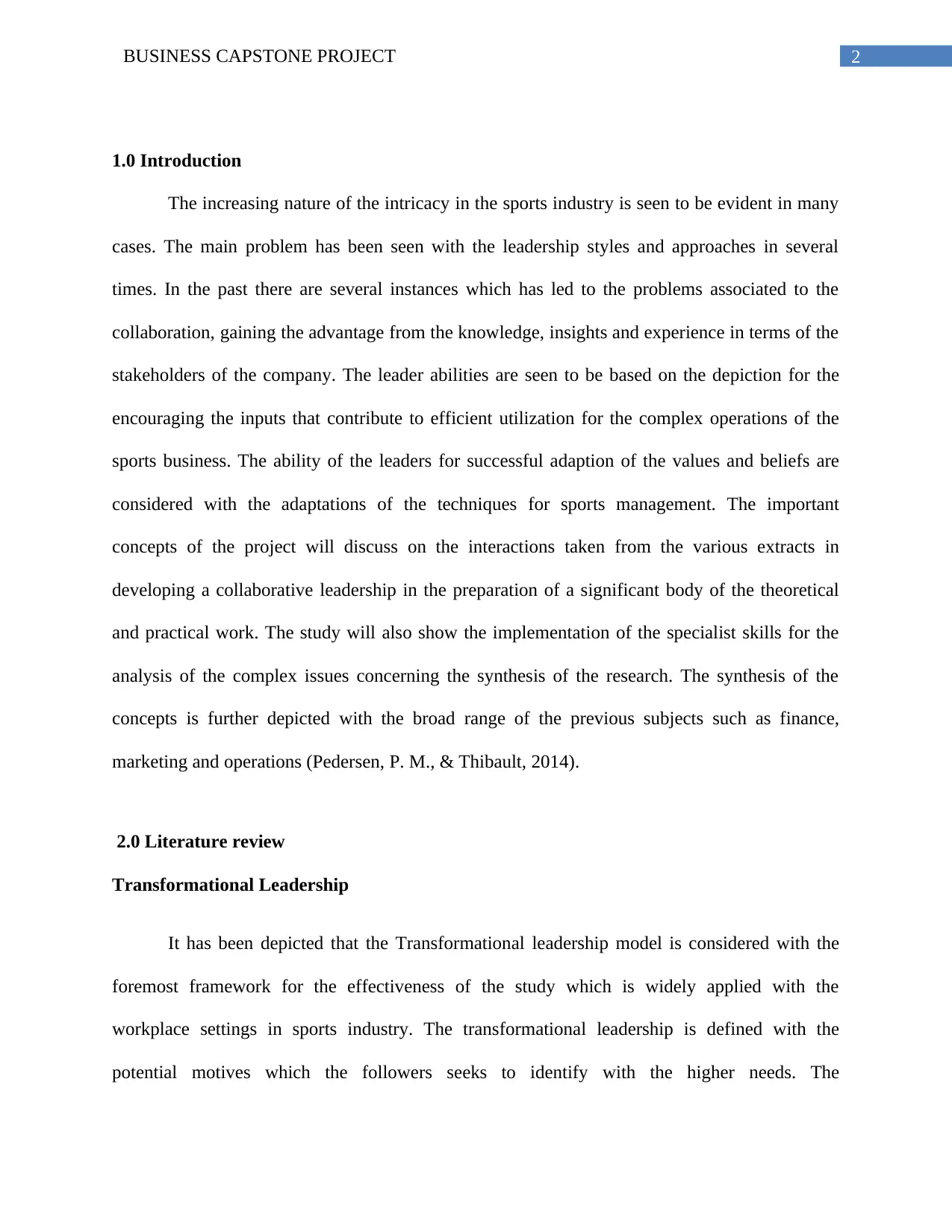
2BUSINESS CAPSTONE PROJECT
1.0 Introduction
The increasing nature of the intricacy in the sports industry is seen to be evident in many
cases. The main problem has been seen with the leadership styles and approaches in several
times. In the past there are several instances which has led to the problems associated to the
collaboration, gaining the advantage from the knowledge, insights and experience in terms of the
stakeholders of the company. The leader abilities are seen to be based on the depiction for the
encouraging the inputs that contribute to efficient utilization for the complex operations of the
sports business. The ability of the leaders for successful adaption of the values and beliefs are
considered with the adaptations of the techniques for sports management. The important
concepts of the project will discuss on the interactions taken from the various extracts in
developing a collaborative leadership in the preparation of a significant body of the theoretical
and practical work. The study will also show the implementation of the specialist skills for the
analysis of the complex issues concerning the synthesis of the research. The synthesis of the
concepts is further depicted with the broad range of the previous subjects such as finance,
marketing and operations (Pedersen, P. M., & Thibault, 2014).
2.0 Literature review
Transformational Leadership
It has been depicted that the Transformational leadership model is considered with the
foremost framework for the effectiveness of the study which is widely applied with the
workplace settings in sports industry. The transformational leadership is defined with the
potential motives which the followers seeks to identify with the higher needs. The
1.0 Introduction
The increasing nature of the intricacy in the sports industry is seen to be evident in many
cases. The main problem has been seen with the leadership styles and approaches in several
times. In the past there are several instances which has led to the problems associated to the
collaboration, gaining the advantage from the knowledge, insights and experience in terms of the
stakeholders of the company. The leader abilities are seen to be based on the depiction for the
encouraging the inputs that contribute to efficient utilization for the complex operations of the
sports business. The ability of the leaders for successful adaption of the values and beliefs are
considered with the adaptations of the techniques for sports management. The important
concepts of the project will discuss on the interactions taken from the various extracts in
developing a collaborative leadership in the preparation of a significant body of the theoretical
and practical work. The study will also show the implementation of the specialist skills for the
analysis of the complex issues concerning the synthesis of the research. The synthesis of the
concepts is further depicted with the broad range of the previous subjects such as finance,
marketing and operations (Pedersen, P. M., & Thibault, 2014).
2.0 Literature review
Transformational Leadership
It has been depicted that the Transformational leadership model is considered with the
foremost framework for the effectiveness of the study which is widely applied with the
workplace settings in sports industry. The transformational leadership is defined with the
potential motives which the followers seeks to identify with the higher needs. The
⊘ This is a preview!⊘
Do you want full access?
Subscribe today to unlock all pages.

Trusted by 1+ million students worldwide
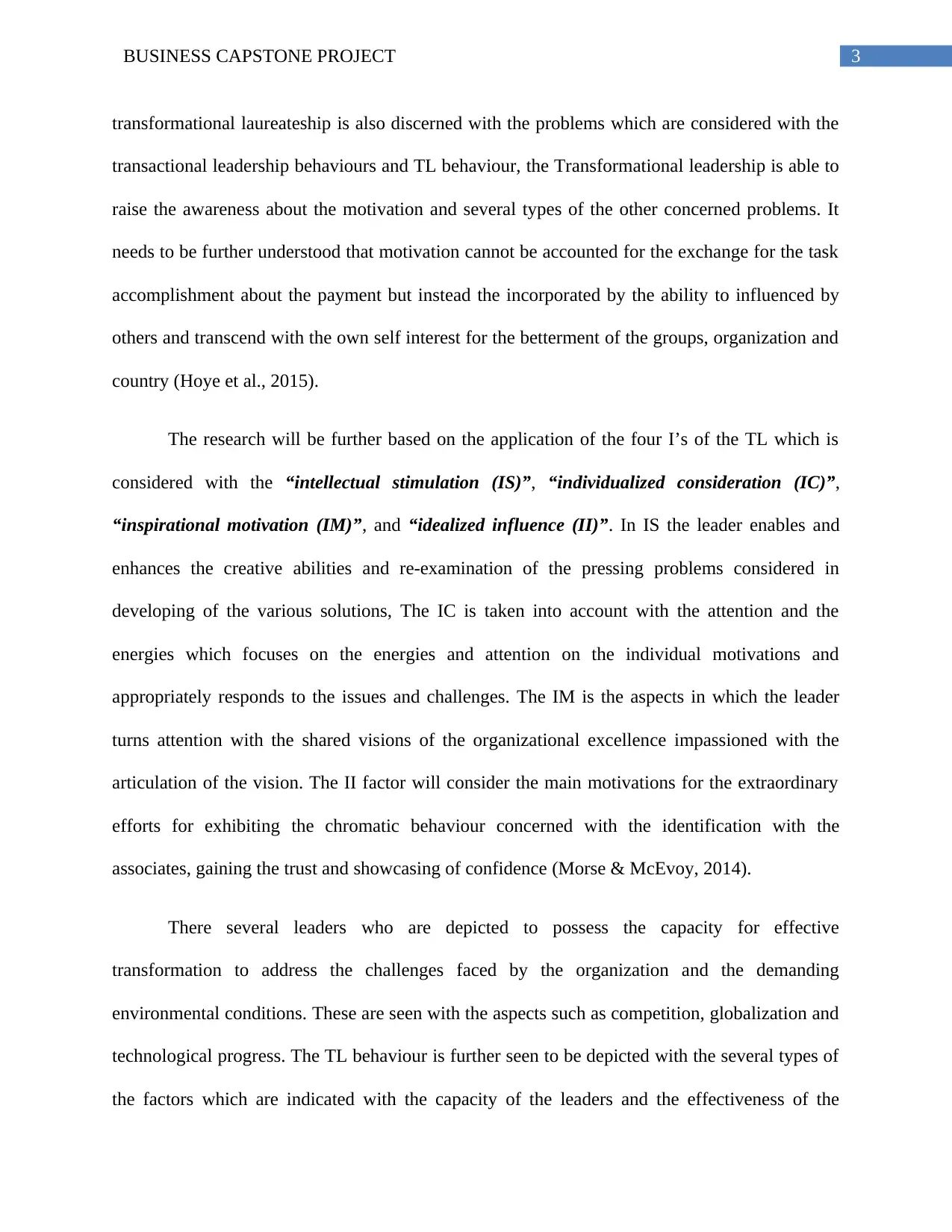
3BUSINESS CAPSTONE PROJECT
transformational laureateship is also discerned with the problems which are considered with the
transactional leadership behaviours and TL behaviour, the Transformational leadership is able to
raise the awareness about the motivation and several types of the other concerned problems. It
needs to be further understood that motivation cannot be accounted for the exchange for the task
accomplishment about the payment but instead the incorporated by the ability to influenced by
others and transcend with the own self interest for the betterment of the groups, organization and
country (Hoye et al., 2015).
The research will be further based on the application of the four I’s of the TL which is
considered with the “intellectual stimulation (IS)”, “individualized consideration (IC)”,
“inspirational motivation (IM)”, and “idealized influence (II)”. In IS the leader enables and
enhances the creative abilities and re-examination of the pressing problems considered in
developing of the various solutions, The IC is taken into account with the attention and the
energies which focuses on the energies and attention on the individual motivations and
appropriately responds to the issues and challenges. The IM is the aspects in which the leader
turns attention with the shared visions of the organizational excellence impassioned with the
articulation of the vision. The II factor will consider the main motivations for the extraordinary
efforts for exhibiting the chromatic behaviour concerned with the identification with the
associates, gaining the trust and showcasing of confidence (Morse & McEvoy, 2014).
There several leaders who are depicted to possess the capacity for effective
transformation to address the challenges faced by the organization and the demanding
environmental conditions. These are seen with the aspects such as competition, globalization and
technological progress. The TL behaviour is further seen to be depicted with the several types of
the factors which are indicated with the capacity of the leaders and the effectiveness of the
transformational laureateship is also discerned with the problems which are considered with the
transactional leadership behaviours and TL behaviour, the Transformational leadership is able to
raise the awareness about the motivation and several types of the other concerned problems. It
needs to be further understood that motivation cannot be accounted for the exchange for the task
accomplishment about the payment but instead the incorporated by the ability to influenced by
others and transcend with the own self interest for the betterment of the groups, organization and
country (Hoye et al., 2015).
The research will be further based on the application of the four I’s of the TL which is
considered with the “intellectual stimulation (IS)”, “individualized consideration (IC)”,
“inspirational motivation (IM)”, and “idealized influence (II)”. In IS the leader enables and
enhances the creative abilities and re-examination of the pressing problems considered in
developing of the various solutions, The IC is taken into account with the attention and the
energies which focuses on the energies and attention on the individual motivations and
appropriately responds to the issues and challenges. The IM is the aspects in which the leader
turns attention with the shared visions of the organizational excellence impassioned with the
articulation of the vision. The II factor will consider the main motivations for the extraordinary
efforts for exhibiting the chromatic behaviour concerned with the identification with the
associates, gaining the trust and showcasing of confidence (Morse & McEvoy, 2014).
There several leaders who are depicted to possess the capacity for effective
transformation to address the challenges faced by the organization and the demanding
environmental conditions. These are seen with the aspects such as competition, globalization and
technological progress. The TL behaviour is further seen to be depicted with the several types of
the factors which are indicated with the capacity of the leaders and the effectiveness of the
Paraphrase This Document
Need a fresh take? Get an instant paraphrase of this document with our AI Paraphraser
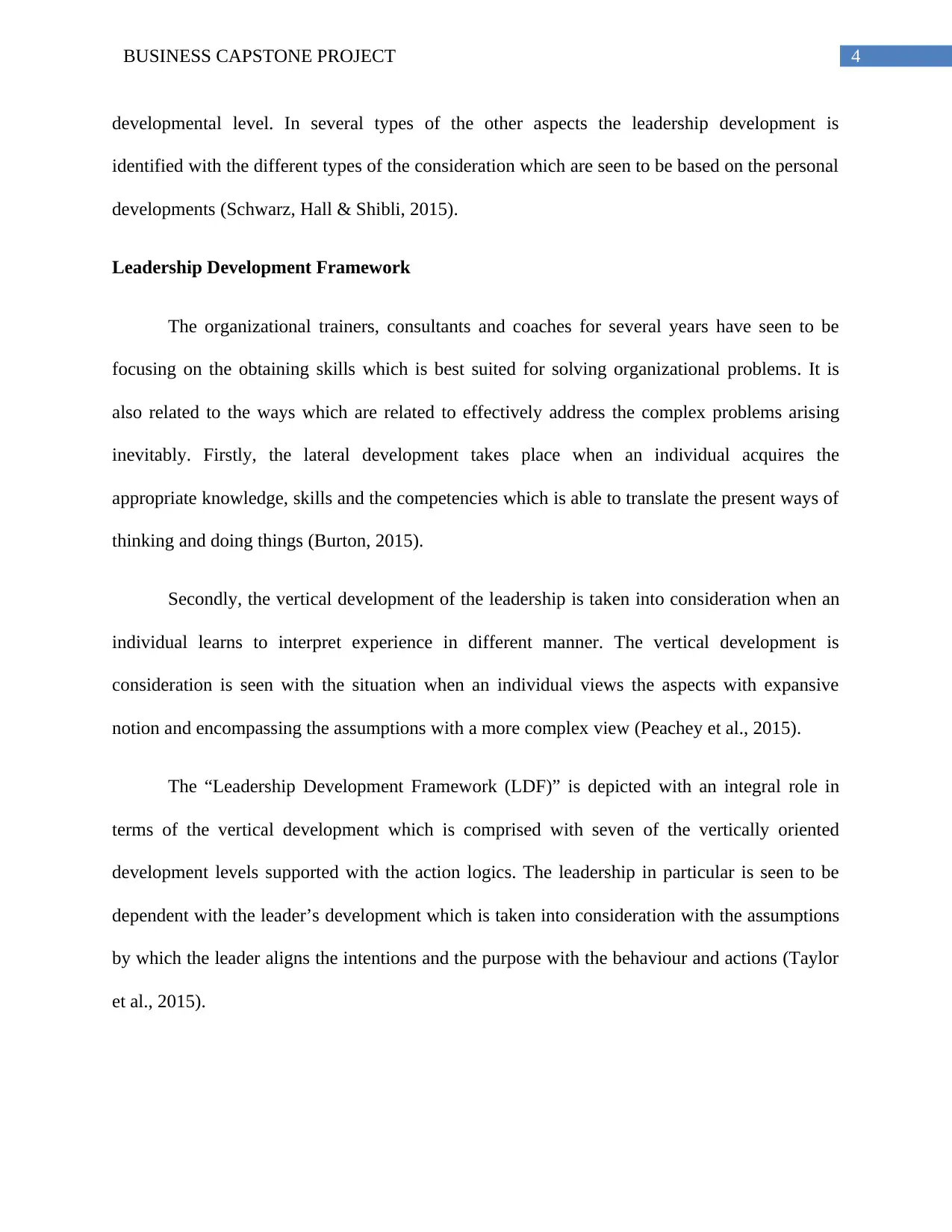
4BUSINESS CAPSTONE PROJECT
developmental level. In several types of the other aspects the leadership development is
identified with the different types of the consideration which are seen to be based on the personal
developments (Schwarz, Hall & Shibli, 2015).
Leadership Development Framework
The organizational trainers, consultants and coaches for several years have seen to be
focusing on the obtaining skills which is best suited for solving organizational problems. It is
also related to the ways which are related to effectively address the complex problems arising
inevitably. Firstly, the lateral development takes place when an individual acquires the
appropriate knowledge, skills and the competencies which is able to translate the present ways of
thinking and doing things (Burton, 2015).
Secondly, the vertical development of the leadership is taken into consideration when an
individual learns to interpret experience in different manner. The vertical development is
consideration is seen with the situation when an individual views the aspects with expansive
notion and encompassing the assumptions with a more complex view (Peachey et al., 2015).
The “Leadership Development Framework (LDF)” is depicted with an integral role in
terms of the vertical development which is comprised with seven of the vertically oriented
development levels supported with the action logics. The leadership in particular is seen to be
dependent with the leader’s development which is taken into consideration with the assumptions
by which the leader aligns the intentions and the purpose with the behaviour and actions (Taylor
et al., 2015).
developmental level. In several types of the other aspects the leadership development is
identified with the different types of the consideration which are seen to be based on the personal
developments (Schwarz, Hall & Shibli, 2015).
Leadership Development Framework
The organizational trainers, consultants and coaches for several years have seen to be
focusing on the obtaining skills which is best suited for solving organizational problems. It is
also related to the ways which are related to effectively address the complex problems arising
inevitably. Firstly, the lateral development takes place when an individual acquires the
appropriate knowledge, skills and the competencies which is able to translate the present ways of
thinking and doing things (Burton, 2015).
Secondly, the vertical development of the leadership is taken into consideration when an
individual learns to interpret experience in different manner. The vertical development is
consideration is seen with the situation when an individual views the aspects with expansive
notion and encompassing the assumptions with a more complex view (Peachey et al., 2015).
The “Leadership Development Framework (LDF)” is depicted with an integral role in
terms of the vertical development which is comprised with seven of the vertically oriented
development levels supported with the action logics. The leadership in particular is seen to be
dependent with the leader’s development which is taken into consideration with the assumptions
by which the leader aligns the intentions and the purpose with the behaviour and actions (Taylor
et al., 2015).
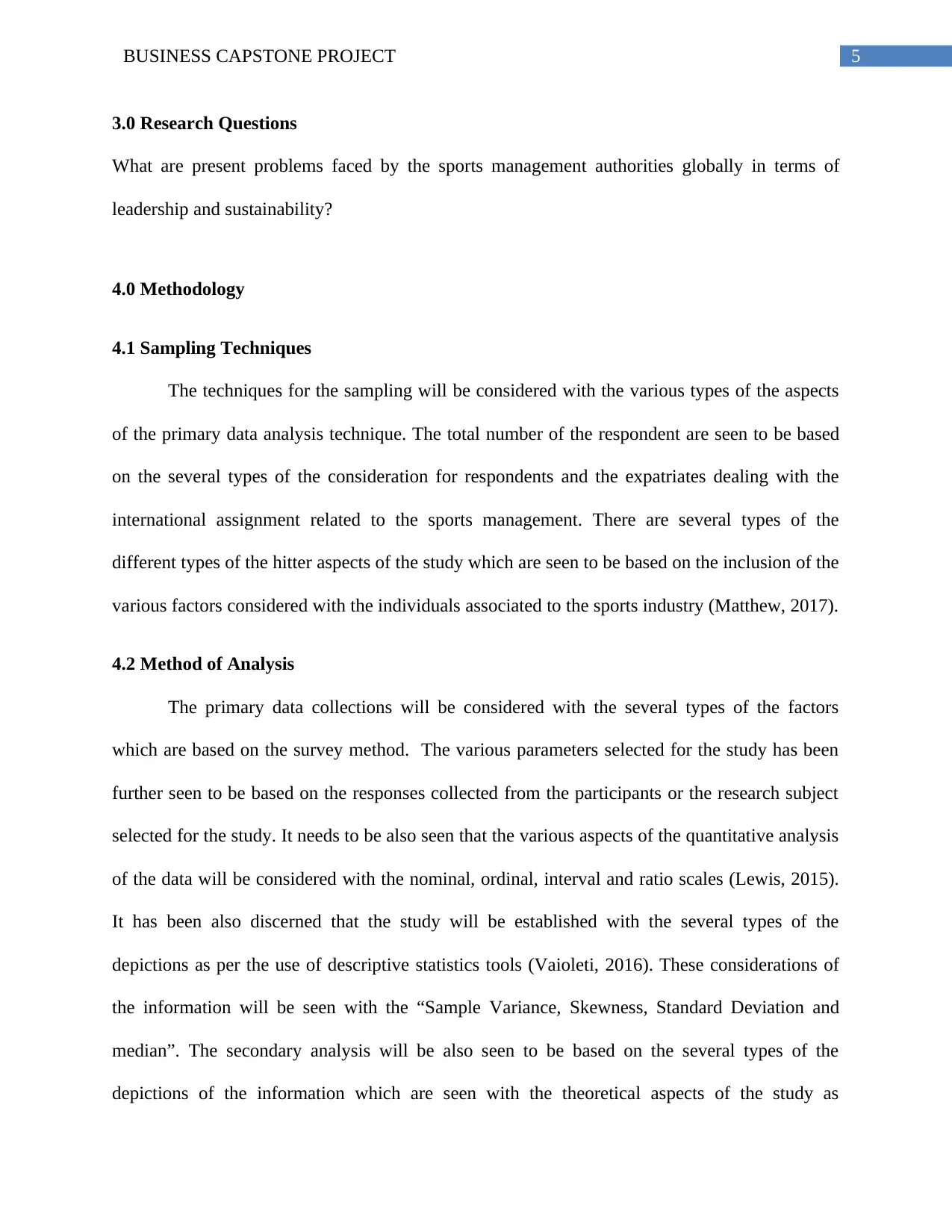
5BUSINESS CAPSTONE PROJECT
3.0 Research Questions
What are present problems faced by the sports management authorities globally in terms of
leadership and sustainability?
4.0 Methodology
4.1 Sampling Techniques
The techniques for the sampling will be considered with the various types of the aspects
of the primary data analysis technique. The total number of the respondent are seen to be based
on the several types of the consideration for respondents and the expatriates dealing with the
international assignment related to the sports management. There are several types of the
different types of the hitter aspects of the study which are seen to be based on the inclusion of the
various factors considered with the individuals associated to the sports industry (Matthew, 2017).
4.2 Method of Analysis
The primary data collections will be considered with the several types of the factors
which are based on the survey method. The various parameters selected for the study has been
further seen to be based on the responses collected from the participants or the research subject
selected for the study. It needs to be also seen that the various aspects of the quantitative analysis
of the data will be considered with the nominal, ordinal, interval and ratio scales (Lewis, 2015).
It has been also discerned that the study will be established with the several types of the
depictions as per the use of descriptive statistics tools (Vaioleti, 2016). These considerations of
the information will be seen with the “Sample Variance, Skewness, Standard Deviation and
median”. The secondary analysis will be also seen to be based on the several types of the
depictions of the information which are seen with the theoretical aspects of the study as
3.0 Research Questions
What are present problems faced by the sports management authorities globally in terms of
leadership and sustainability?
4.0 Methodology
4.1 Sampling Techniques
The techniques for the sampling will be considered with the various types of the aspects
of the primary data analysis technique. The total number of the respondent are seen to be based
on the several types of the consideration for respondents and the expatriates dealing with the
international assignment related to the sports management. There are several types of the
different types of the hitter aspects of the study which are seen to be based on the inclusion of the
various factors considered with the individuals associated to the sports industry (Matthew, 2017).
4.2 Method of Analysis
The primary data collections will be considered with the several types of the factors
which are based on the survey method. The various parameters selected for the study has been
further seen to be based on the responses collected from the participants or the research subject
selected for the study. It needs to be also seen that the various aspects of the quantitative analysis
of the data will be considered with the nominal, ordinal, interval and ratio scales (Lewis, 2015).
It has been also discerned that the study will be established with the several types of the
depictions as per the use of descriptive statistics tools (Vaioleti, 2016). These considerations of
the information will be seen with the “Sample Variance, Skewness, Standard Deviation and
median”. The secondary analysis will be also seen to be based on the several types of the
depictions of the information which are seen with the theoretical aspects of the study as
⊘ This is a preview!⊘
Do you want full access?
Subscribe today to unlock all pages.

Trusted by 1+ million students worldwide
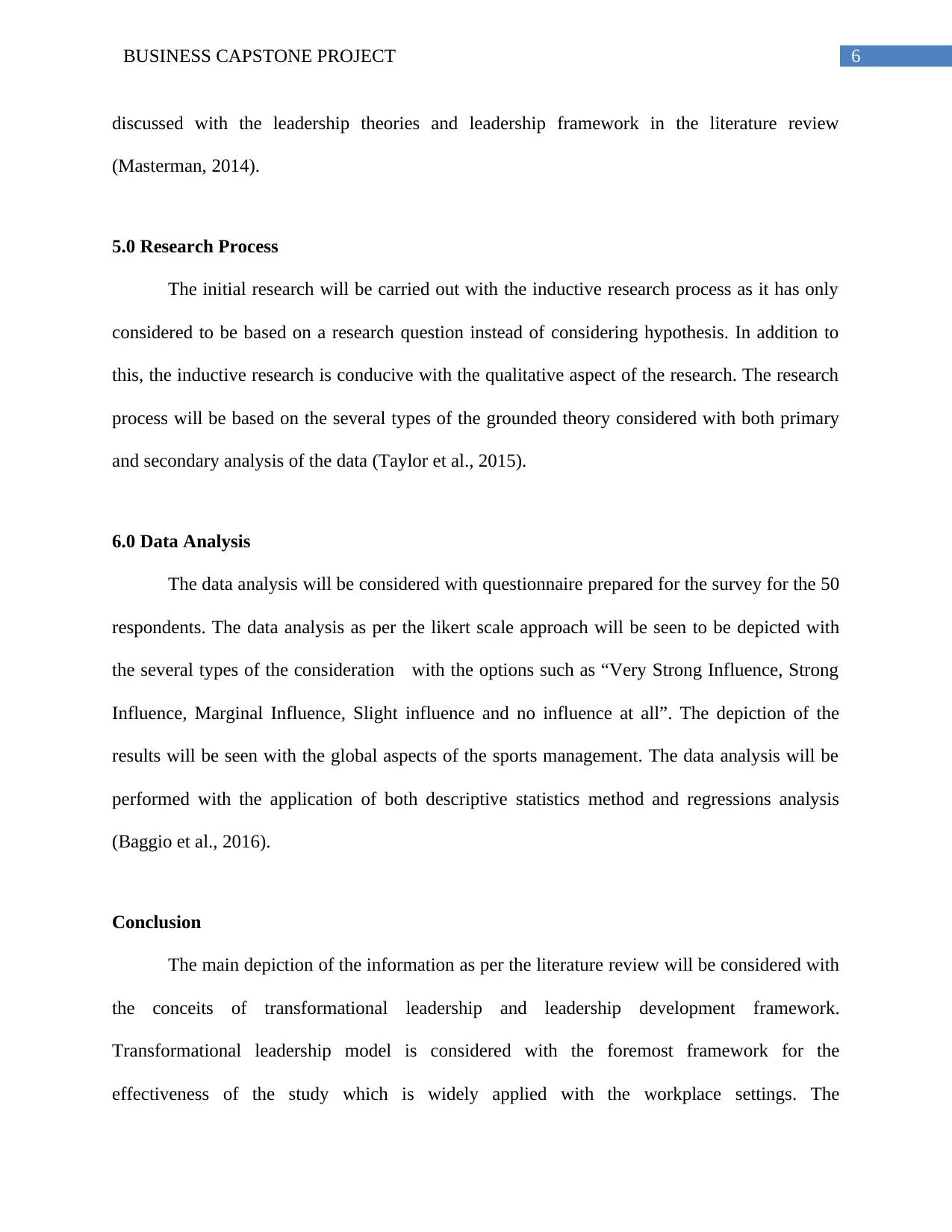
6BUSINESS CAPSTONE PROJECT
discussed with the leadership theories and leadership framework in the literature review
(Masterman, 2014).
5.0 Research Process
The initial research will be carried out with the inductive research process as it has only
considered to be based on a research question instead of considering hypothesis. In addition to
this, the inductive research is conducive with the qualitative aspect of the research. The research
process will be based on the several types of the grounded theory considered with both primary
and secondary analysis of the data (Taylor et al., 2015).
6.0 Data Analysis
The data analysis will be considered with questionnaire prepared for the survey for the 50
respondents. The data analysis as per the likert scale approach will be seen to be depicted with
the several types of the consideration with the options such as “Very Strong Influence, Strong
Influence, Marginal Influence, Slight influence and no influence at all”. The depiction of the
results will be seen with the global aspects of the sports management. The data analysis will be
performed with the application of both descriptive statistics method and regressions analysis
(Baggio et al., 2016).
Conclusion
The main depiction of the information as per the literature review will be considered with
the conceits of transformational leadership and leadership development framework.
Transformational leadership model is considered with the foremost framework for the
effectiveness of the study which is widely applied with the workplace settings. The
discussed with the leadership theories and leadership framework in the literature review
(Masterman, 2014).
5.0 Research Process
The initial research will be carried out with the inductive research process as it has only
considered to be based on a research question instead of considering hypothesis. In addition to
this, the inductive research is conducive with the qualitative aspect of the research. The research
process will be based on the several types of the grounded theory considered with both primary
and secondary analysis of the data (Taylor et al., 2015).
6.0 Data Analysis
The data analysis will be considered with questionnaire prepared for the survey for the 50
respondents. The data analysis as per the likert scale approach will be seen to be depicted with
the several types of the consideration with the options such as “Very Strong Influence, Strong
Influence, Marginal Influence, Slight influence and no influence at all”. The depiction of the
results will be seen with the global aspects of the sports management. The data analysis will be
performed with the application of both descriptive statistics method and regressions analysis
(Baggio et al., 2016).
Conclusion
The main depiction of the information as per the literature review will be considered with
the conceits of transformational leadership and leadership development framework.
Transformational leadership model is considered with the foremost framework for the
effectiveness of the study which is widely applied with the workplace settings. The
Paraphrase This Document
Need a fresh take? Get an instant paraphrase of this document with our AI Paraphraser
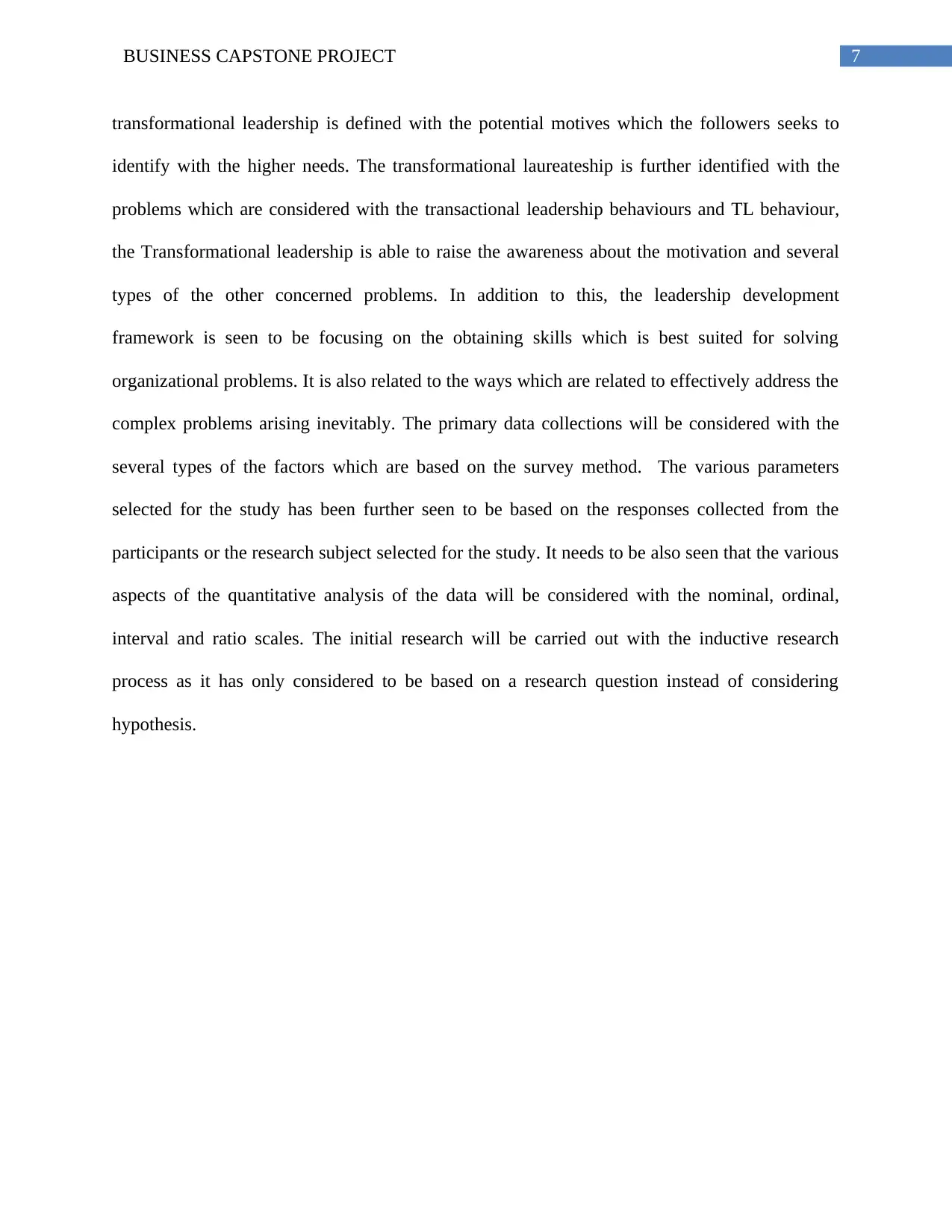
7BUSINESS CAPSTONE PROJECT
transformational leadership is defined with the potential motives which the followers seeks to
identify with the higher needs. The transformational laureateship is further identified with the
problems which are considered with the transactional leadership behaviours and TL behaviour,
the Transformational leadership is able to raise the awareness about the motivation and several
types of the other concerned problems. In addition to this, the leadership development
framework is seen to be focusing on the obtaining skills which is best suited for solving
organizational problems. It is also related to the ways which are related to effectively address the
complex problems arising inevitably. The primary data collections will be considered with the
several types of the factors which are based on the survey method. The various parameters
selected for the study has been further seen to be based on the responses collected from the
participants or the research subject selected for the study. It needs to be also seen that the various
aspects of the quantitative analysis of the data will be considered with the nominal, ordinal,
interval and ratio scales. The initial research will be carried out with the inductive research
process as it has only considered to be based on a research question instead of considering
hypothesis.
transformational leadership is defined with the potential motives which the followers seeks to
identify with the higher needs. The transformational laureateship is further identified with the
problems which are considered with the transactional leadership behaviours and TL behaviour,
the Transformational leadership is able to raise the awareness about the motivation and several
types of the other concerned problems. In addition to this, the leadership development
framework is seen to be focusing on the obtaining skills which is best suited for solving
organizational problems. It is also related to the ways which are related to effectively address the
complex problems arising inevitably. The primary data collections will be considered with the
several types of the factors which are based on the survey method. The various parameters
selected for the study has been further seen to be based on the responses collected from the
participants or the research subject selected for the study. It needs to be also seen that the various
aspects of the quantitative analysis of the data will be considered with the nominal, ordinal,
interval and ratio scales. The initial research will be carried out with the inductive research
process as it has only considered to be based on a research question instead of considering
hypothesis.
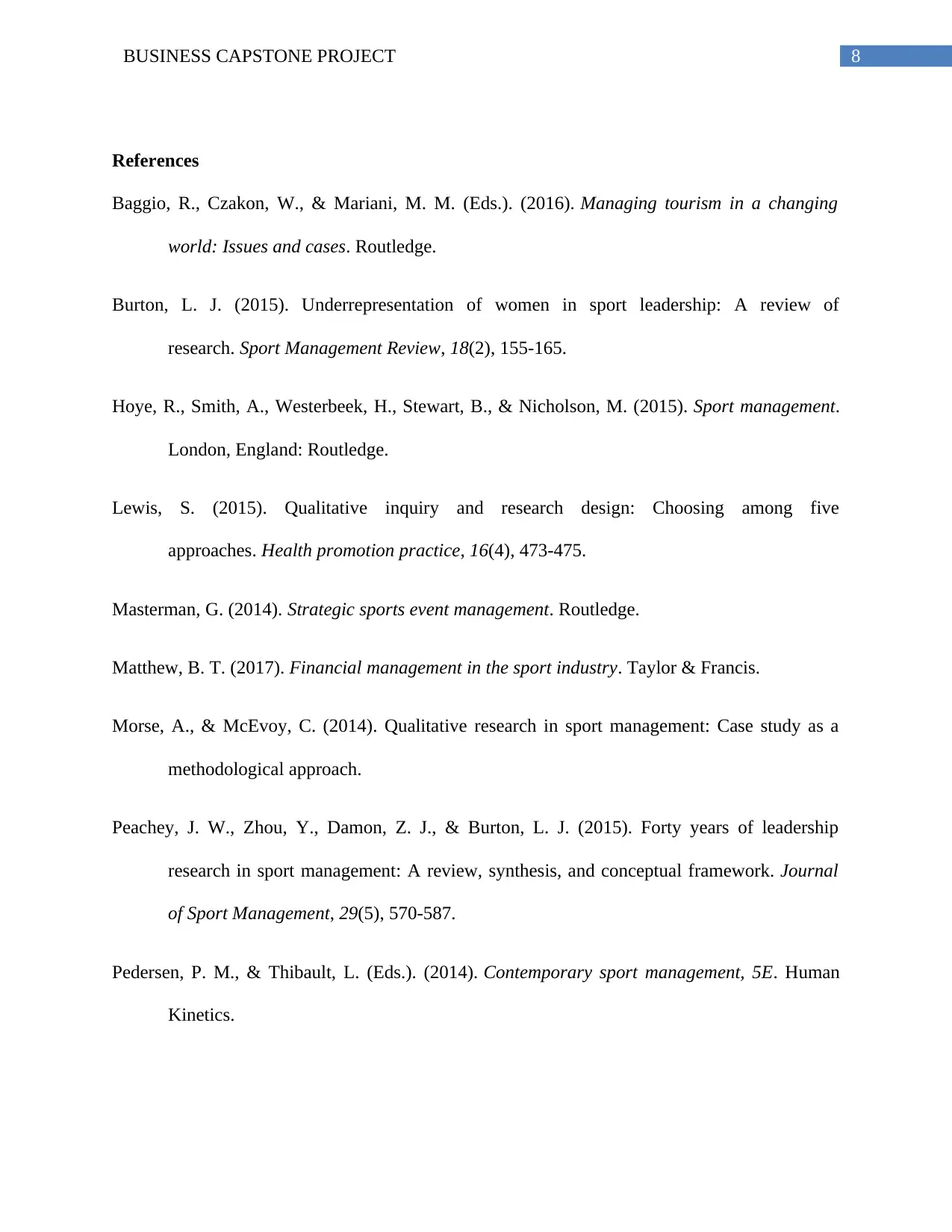
8BUSINESS CAPSTONE PROJECT
References
Baggio, R., Czakon, W., & Mariani, M. M. (Eds.). (2016). Managing tourism in a changing
world: Issues and cases. Routledge.
Burton, L. J. (2015). Underrepresentation of women in sport leadership: A review of
research. Sport Management Review, 18(2), 155-165.
Hoye, R., Smith, A., Westerbeek, H., Stewart, B., & Nicholson, M. (2015). Sport management.
London, England: Routledge.
Lewis, S. (2015). Qualitative inquiry and research design: Choosing among five
approaches. Health promotion practice, 16(4), 473-475.
Masterman, G. (2014). Strategic sports event management. Routledge.
Matthew, B. T. (2017). Financial management in the sport industry. Taylor & Francis.
Morse, A., & McEvoy, C. (2014). Qualitative research in sport management: Case study as a
methodological approach.
Peachey, J. W., Zhou, Y., Damon, Z. J., & Burton, L. J. (2015). Forty years of leadership
research in sport management: A review, synthesis, and conceptual framework. Journal
of Sport Management, 29(5), 570-587.
Pedersen, P. M., & Thibault, L. (Eds.). (2014). Contemporary sport management, 5E. Human
Kinetics.
References
Baggio, R., Czakon, W., & Mariani, M. M. (Eds.). (2016). Managing tourism in a changing
world: Issues and cases. Routledge.
Burton, L. J. (2015). Underrepresentation of women in sport leadership: A review of
research. Sport Management Review, 18(2), 155-165.
Hoye, R., Smith, A., Westerbeek, H., Stewart, B., & Nicholson, M. (2015). Sport management.
London, England: Routledge.
Lewis, S. (2015). Qualitative inquiry and research design: Choosing among five
approaches. Health promotion practice, 16(4), 473-475.
Masterman, G. (2014). Strategic sports event management. Routledge.
Matthew, B. T. (2017). Financial management in the sport industry. Taylor & Francis.
Morse, A., & McEvoy, C. (2014). Qualitative research in sport management: Case study as a
methodological approach.
Peachey, J. W., Zhou, Y., Damon, Z. J., & Burton, L. J. (2015). Forty years of leadership
research in sport management: A review, synthesis, and conceptual framework. Journal
of Sport Management, 29(5), 570-587.
Pedersen, P. M., & Thibault, L. (Eds.). (2014). Contemporary sport management, 5E. Human
Kinetics.
⊘ This is a preview!⊘
Do you want full access?
Subscribe today to unlock all pages.

Trusted by 1+ million students worldwide
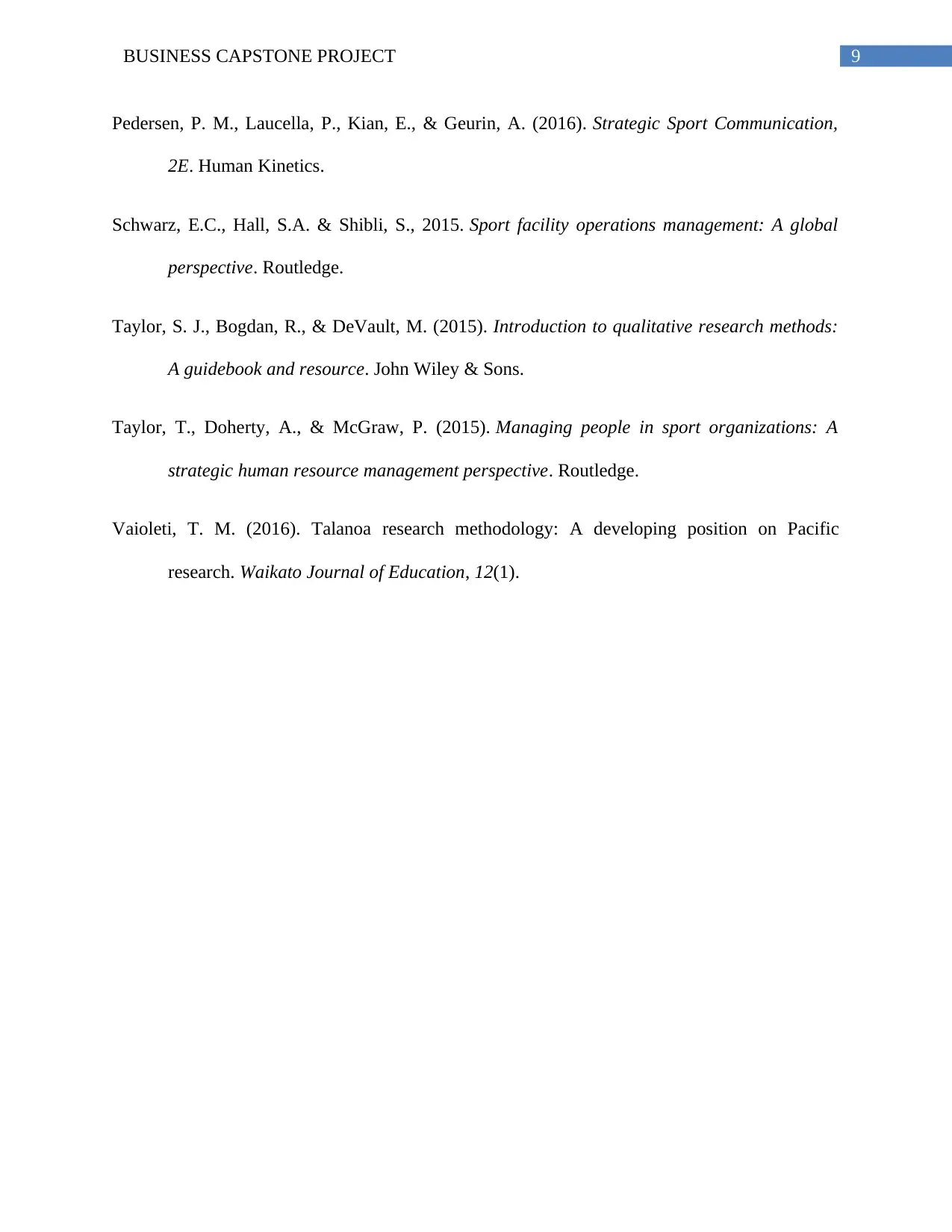
9BUSINESS CAPSTONE PROJECT
Pedersen, P. M., Laucella, P., Kian, E., & Geurin, A. (2016). Strategic Sport Communication,
2E. Human Kinetics.
Schwarz, E.C., Hall, S.A. & Shibli, S., 2015. Sport facility operations management: A global
perspective. Routledge.
Taylor, S. J., Bogdan, R., & DeVault, M. (2015). Introduction to qualitative research methods:
A guidebook and resource. John Wiley & Sons.
Taylor, T., Doherty, A., & McGraw, P. (2015). Managing people in sport organizations: A
strategic human resource management perspective. Routledge.
Vaioleti, T. M. (2016). Talanoa research methodology: A developing position on Pacific
research. Waikato Journal of Education, 12(1).
Pedersen, P. M., Laucella, P., Kian, E., & Geurin, A. (2016). Strategic Sport Communication,
2E. Human Kinetics.
Schwarz, E.C., Hall, S.A. & Shibli, S., 2015. Sport facility operations management: A global
perspective. Routledge.
Taylor, S. J., Bogdan, R., & DeVault, M. (2015). Introduction to qualitative research methods:
A guidebook and resource. John Wiley & Sons.
Taylor, T., Doherty, A., & McGraw, P. (2015). Managing people in sport organizations: A
strategic human resource management perspective. Routledge.
Vaioleti, T. M. (2016). Talanoa research methodology: A developing position on Pacific
research. Waikato Journal of Education, 12(1).
1 out of 10
Related Documents
Your All-in-One AI-Powered Toolkit for Academic Success.
+13062052269
info@desklib.com
Available 24*7 on WhatsApp / Email
![[object Object]](/_next/static/media/star-bottom.7253800d.svg)
Unlock your academic potential
Copyright © 2020–2025 A2Z Services. All Rights Reserved. Developed and managed by ZUCOL.





